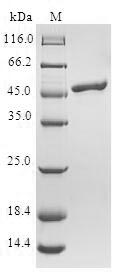The generation of the recombinant Human TCAP protein typically includes the following steps: synthesizing the recombinant plasmid containing the gene encoding the Human TCAP protein (1-167aa), transforming the recombinant plasmid into e.coli cells, selecting the positive e.coli cells, and culturing the positive e.coli cells for protein expression. The protein is equipped with a N-terminal GST tag. After expression, affinity purification is employed to isolate and purify the recombinant TCAP protein from the cell lysate. Denaturing SDS-PAGE is utilized to resolve the resulting recombinant Human TCAP protein, revealing a purity level exceeding 90%.






